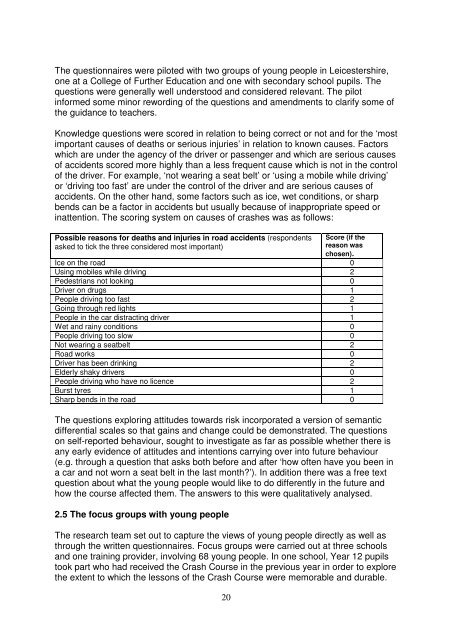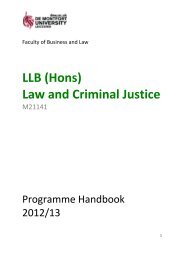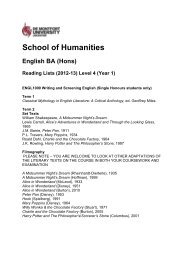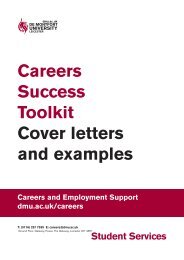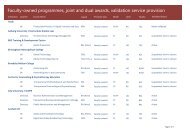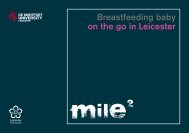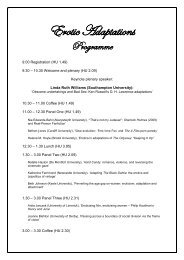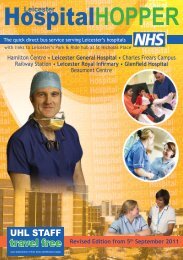Evaluation of the Crash Course March 2009 - De Montfort University
Evaluation of the Crash Course March 2009 - De Montfort University
Evaluation of the Crash Course March 2009 - De Montfort University
Create successful ePaper yourself
Turn your PDF publications into a flip-book with our unique Google optimized e-Paper software.
The questionnaires were piloted with two groups <strong>of</strong> young people in Leicestershire,<br />
one at a College <strong>of</strong> Fur<strong>the</strong>r Education and one with secondary school pupils. The<br />
questions were generally well understood and considered relevant. The pilot<br />
informed some minor rewording <strong>of</strong> <strong>the</strong> questions and amendments to clarify some <strong>of</strong><br />
<strong>the</strong> guidance to teachers.<br />
Knowledge questions were scored in relation to being correct or not and for <strong>the</strong> ‘most<br />
important causes <strong>of</strong> deaths or serious injuries’ in relation to known causes. Factors<br />
which are under <strong>the</strong> agency <strong>of</strong> <strong>the</strong> driver or passenger and which are serious causes<br />
<strong>of</strong> accidents scored more highly than a less frequent cause which is not in <strong>the</strong> control<br />
<strong>of</strong> <strong>the</strong> driver. For example, ‘not wearing a seat belt’ or ‘using a mobile while driving’<br />
or ‘driving too fast’ are under <strong>the</strong> control <strong>of</strong> <strong>the</strong> driver and are serious causes <strong>of</strong><br />
accidents. On <strong>the</strong> o<strong>the</strong>r hand, some factors such as ice, wet conditions, or sharp<br />
bends can be a factor in accidents but usually because <strong>of</strong> inappropriate speed or<br />
inattention. The scoring system on causes <strong>of</strong> crashes was as follows:<br />
Possible reasons for deaths and injuries in road accidents (respondents<br />
asked to tick <strong>the</strong> three considered most important)<br />
20<br />
Score (if <strong>the</strong><br />
reason was<br />
chosen).<br />
Ice on <strong>the</strong> road 0<br />
Using mobiles while driving 2<br />
Pedestrians not looking 0<br />
Driver on drugs 1<br />
People driving too fast 2<br />
Going through red lights 1<br />
People in <strong>the</strong> car distracting driver 1<br />
Wet and rainy conditions 0<br />
People driving too slow 0<br />
Not wearing a seatbelt 2<br />
Road works 0<br />
Driver has been drinking 2<br />
Elderly shaky drivers 0<br />
People driving who have no licence 2<br />
Burst tyres 1<br />
Sharp bends in <strong>the</strong> road 0<br />
The questions exploring attitudes towards risk incorporated a version <strong>of</strong> semantic<br />
differential scales so that gains and change could be demonstrated. The questions<br />
on self-reported behaviour, sought to investigate as far as possible whe<strong>the</strong>r <strong>the</strong>re is<br />
any early evidence <strong>of</strong> attitudes and intentions carrying over into future behaviour<br />
(e.g. through a question that asks both before and after ‘how <strong>of</strong>ten have you been in<br />
a car and not worn a seat belt in <strong>the</strong> last month?’). In addition <strong>the</strong>re was a free text<br />
question about what <strong>the</strong> young people would like to do differently in <strong>the</strong> future and<br />
how <strong>the</strong> course affected <strong>the</strong>m. The answers to this were qualitatively analysed.<br />
2.5 The focus groups with young people<br />
The research team set out to capture <strong>the</strong> views <strong>of</strong> young people directly as well as<br />
through <strong>the</strong> written questionnaires. Focus groups were carried out at three schools<br />
and one training provider, involving 68 young people. In one school, Year 12 pupils<br />
took part who had received <strong>the</strong> <strong>Crash</strong> <strong>Course</strong> in <strong>the</strong> previous year in order to explore<br />
<strong>the</strong> extent to which <strong>the</strong> lessons <strong>of</strong> <strong>the</strong> <strong>Crash</strong> <strong>Course</strong> were memorable and durable.


